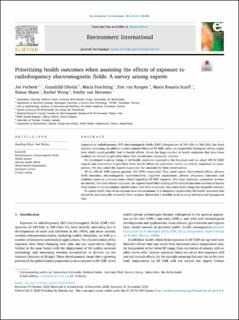| dc.description.abstract | Exposure to radiofrequency (RF) electromagnetic fields (EMF) (frequencies of 100 kHz to 300 GHz) has been steadily increasing. In addition to heat-related effects of RF EMF, other yet-unspecified biological effects, might exist which could possibly lead to health effects. Given the large number of health endpoints that have been studied, we wanted to prioritize those that would merit systematic reviews.
We developed a survey listing of all health endpoints reported in the literature and we asked 300 RF EMF experts and researchers to prioritize these health effects for systematic review as critical, important or unimportant. We also asked the experts to provide the rationale for their prioritization.
Of the 300 RF EMF experts queried, 164 (54%) responded. They rated cancer, heat-related effects, adverse birth outcomes, electromagnetic hypersensitivity, cognitive impairment, adverse pregnancy outcomes and oxidative stress as outcomes most critical regarding RF EMF exposure. For these outcomes, systematic reviews are needed. For heat-related outcomes, the experts based their ranking of the critical outcomes on what is known from human or animal studies, and for cancer and other outcomes, they based their rating also on public concern.
To assess health risks of an exposure in a robust manner, it is important to prioritize the health outcomes that should be systematically reviewed. Here we have shown that it feasible to do so in an inclusive and transparent way. | en_US |

